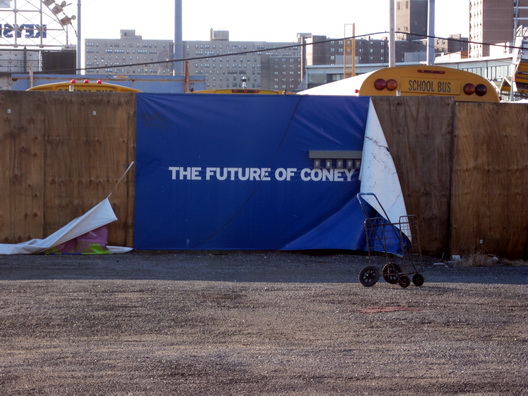We awoke this morning and thought we were still dreaming. Charles Bagli of the New York Times has finally focused on Coney Island. Of course, to close Coney watchers it’s the once-over lightly and fails to capture the truly ugly nature of the ongoing battle for Coney Island. The story is exceptionally kind to developer Joe Sitt and fails to fully note his deliberate tactic of either literally or tacitly threatening to level parts of Coney’s sadly diminished amusement area to pressure city officials. It skips over the ugly public catfight between the developer and the city. Yet, it does manage to lay out for the average readers some of the sharply differing visions in the various concepts of what should happen in Coney.
The story notes the city “recently introduced” a plan for a 9.4 acre amusement district (it introduced a plan for a 16 acre one in November 2007 and trimmed it to 9.4 acres nearly a year ago). We suppose this qualifies as “recently,” given that the city’s most important publication has acted as though Coney Island is in Moldova. We digress. Here’s a small sample of the story:
In the latest in a long line of efforts to revamp or revive the onetime resort, the Bloomberg administration recently introduced its plan to develop a year-round amusement and entertainment destination, with a special 9.4-acre amusement district, as well as new housing, shops and parks. And in keeping with the waterfront’s contentious history, a prominent civic organization and a developer, who has spent over $100 million buying up property in the area, have put forward competing visions of how to best preserve the soul and mythology of Coney Island. The civic group, the Municipal Art Society, contends that the Bloomberg administration’s plan must be bigger and bolder to be successful, with three times as much land dedicated solely to outlandish amusements and an “eye-popping” attraction akin to the London Eye, a 443-foot high Ferris wheel.
Again, the story fails to note that the MAS (which we deeply respect) is a very late comer to a struggle that has been going on for more than three years. They are akin to a team that has walked on to the playing field in the Fourth Quarter with 2:00 left on the clock. (And, yes, we realize it is the good people at the MAS that finally got the Times to realize that Coney Island is actually in Brookyn, not a former Soviet republic.) The story quotes developer Joe Sitt as calling the city and MSA proposals as “seriously flawed” and doomed. Mr. Sitt, as always, still insists that Coney needs time-share hotels and large retail shops.
The goes on to note Mr. Sitt’s strategy of negotiating via developer blight–of demolition and eviction of attractions like Astroland–and of the ongoing effort by the city to buy five of Mr. Sitt’s 10 acres of land. (A huge and divisive concession, because its original plan wanted all of the developer’s property.) Mr. Bagli also points out the fact that the city could use eminent domain to get Mr. Sitt’s land, but that tactic would only result in years of legal battles that could make the Atlantic Yards litigation look speedy.
The story touches on the economic reality of 2009 versus the plans of 2007 as well, but fails to note the city’s wretched failure to come up with an interim strategy so that Coney can outlast the current Depression-Recession even if agreements are reached as the cold reality is that nothing is going to be financed and built for at least five years. Those could be five long years:
The issues are only further complicated by the recession, sharply declining retail sales and the inability to get financing for any project, regardless of who the developer is. Many residents of Coney Island are more concerned with affordable housing, jobs and attracting grocery stores to the area than the nuances of rebuilding the amusement district, although no one wants it to close down. The beaches, a minor league ballpark and what’s left of the amusements still attract millions of summer visitors.
“We hope that there’ll be some sort of marriage of convenience so we don’t lose any summers, especially now with a depression, when more people may choose to come to Coney Island,” said Chuck Reichenthal, district manager for Community Board 13.
There is more and we encourage everyone to read, but the Money Quote comes from Charles Denson, founder of the Coney History Project and eminent Coney historian. Mr. Denson seems to be the only one quoted in the story who gets it: “We might be looking at vacant lots for a long time to come. Everybody’s broke. These massive plans, these visions, don’t usually work. But I hope for the best.”
Which, of course, is why we’re tired of hearing about “vision” and “plans” for Coney Island. What Coney needs more than anything is a quick agreement with Mr. Sitt, who can be pressured if he ever wants to build an outhouse in New York City again, and an interim plan to prevent Developer and Municipal Blight of Biblical Proportions. That would be the ultimate insult to a place that has suffered so much, for so long. The answer, really, is quite simple: make sure there are carnival rides, games, places for people to eat and drink. And, when the market recovers, build a world class amusement park.


1 response so far ↓
1 Jim // Feb 17, 2009 at 12:15 pm
The Times has to be kind to developers like Sitt because they also shell out advertising bucks and newspapers don’t want to piss them off.